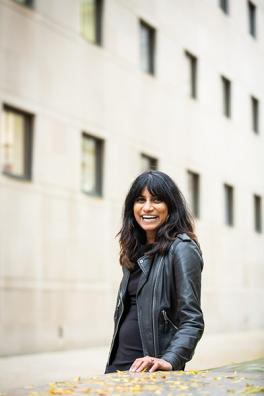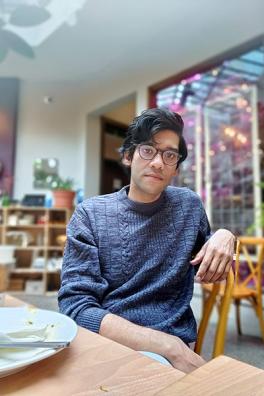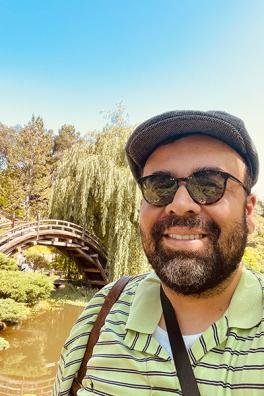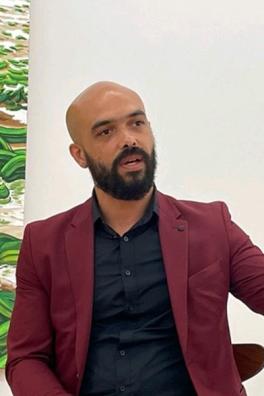Sampada Aranke

Associate Professor of History of Art and Comparative Studies
Tell us about your research!
My research interests include performance theories of embodiment, visual culture and black cultural and aesthetic theory. My book, Death’s Futurity: The Visual Life of Black Power was published in February 2023 with Duke University Press. In it, I examine the importance of representations of death to Black liberation. I analyze posters, photographs, journalism and films that focus on the murders of Black Panther Party members Lil’ Bobby Hutton, Fred Hampton and George Jackson to construct a visual history of the 1960s and 1970s Black Power era. I am working on a book-length project tentatively called The Hammons Effect which examines how the famed Black conceptual artist David Hammons helps us develop new ways to write contemporary art history. Most recently, I conducted archival research at the Driskell Center toward this project.
Are there opportunities at Ohio State that you are particularly excited about, or courses you are particularly looking forward to teaching?
I am excited to teach courses on Black American art history and art since 1945. I am also very excited about partnering with the Hale Center to teach out of the Hale Art Collection. I also am thrilled to be the associate director of the Center for Ethnic Studies. I am so very happy to be here and look forward to building meaningful relationships with my students!
Ujaan Ghosh
Assistant Professor of History of Art

Tell us about your research!
I am presently working on my book project that looks at the interaction between global visual cultures and local spatial practices in colonial India. The project interrogates the ways in which the experience of colonialism shapes the contours of everyday tactics of space-making in the colony and the representation of the colonized in the Imperial metropolis and beyond. The site of my research is the Hindu temple town of Puri, whose contested biography the project follows as it traverses across India, Britain, and America. Through this project, I rethink ideas of colonial visual cultures venturing beyond the binaries established by the metropole and colony. Additionally, I am working on another project on the question of the constituent components of vernacularity in regional retellings of epics in India. Amongst other things, I am interested in the ways in which visually (through illustrated manuscripts and temple sculptures) and textually regional epics articulated ideas of social justice in (pre) modern India.
Are there opportunities at Ohio State that you are particularly excited about, or courses you are particularly looking forward to teaching?
Ohio State has historically been one of the epicenters of South Asian art history, for years producing generations of scholars from this department. So I am really excited to be here and hopefully play a meaningful role in the future. I am eager to teach our students the upcoming courses focusing on theories and methods of art history. Very few courses give you the opportunity to shape the minds of future art historians as methods, so I am eager to engage with the students and guide them through their intellectual journey. In the future, I plan to develop a course on visual cultures of India, titled “Buddha to Bollywood.” The course will give students a panoramic view of Indian art history. Finally, I am working on another course, on monsters, visual cultures and global art history, possibly titled “The Devil in the Details” (but I am open to suggestions).
Carlos Rivas
Assistant Professor of History of Art and Ethnic Studies

Tell us about your research!
I work on the history of Latin American visual culture from the early modern period to today, with a focus on southern Mesoamerica. I am currently working on a monograph that analyzes the maps of the lengthy 1770 manuscript the Descripción Geográfico-Moral de la Diócesis de Goathemala, or “Geographical and Moral Description of the Diocese of Guatemala.” These maps provide some of the most comprehensive geospatial and cartographical information about the northern portion of the Central American isthmus during the age of the Bourbon Reforms, a period in which the Spanish crown sought to introduce sweeping change in its American colonies. In my art historical analysis, I contextualize these maps within the broader history of Spanish colonial cartographic production and argue that they signify changing attitudes about the geopolitical significance of this part of the Spanish empire.
Are there opportunities at Ohio State that you are particularly excited about, or courses you are particularly looking forward to teaching?
Coming to Ohio State has been so exciting because of all of the innovative research happening across campus. I am especially interested in working with the Center for Ethnic Studies and further developing the Latinx Studies program. As the Latinx community in Ohio (and on campus) continues to grow, Ohio State will be a vital center for understanding the Midwest as an increasingly important migration destination in the U.S. that will no doubt continue to receive immigrants and refugees from Latin America (and the world). I look forward to continuing to teach and develop courses that feature artistic and visual culture of these diasporic Latin American communities.
Benjamin Jones
Provost’s Fellow in History of Art

Tell us about your research!
I’m in the early stages of drafting a historiographic essay, tentatively titled “Art History as an Expanded Field,” which is concerned with the trajectories and limitations of our discipline. This comes as reflective work that aligns with the ambitions of three parallel book projects. The first to launch will be What We Cain’t Do: The Pedagogy of the Black Radical Aesthetic Tradition, followed by What We Fin’na Do: Afterlives of the Underground Railroad in Art, and an art book published in pencil and mixed media titled What We Fin’na Do: Preface to a 5,000 Year Almanac.
Are there opportunities at Ohio State that you are particularly excited about, or courses you are particularly looking forward to teaching?
As a new arrival to Ohio State, I was drawn to the warmth and congeniality of our department and broader community. I’m particularly excited about the momentum the Department of History of Art has going. I look forward to continuing to build on the strengths of the department by fostering connections with local and global interlocutors, mostly by way of The Samella Lewis Initiative for the Study of Black Art.
